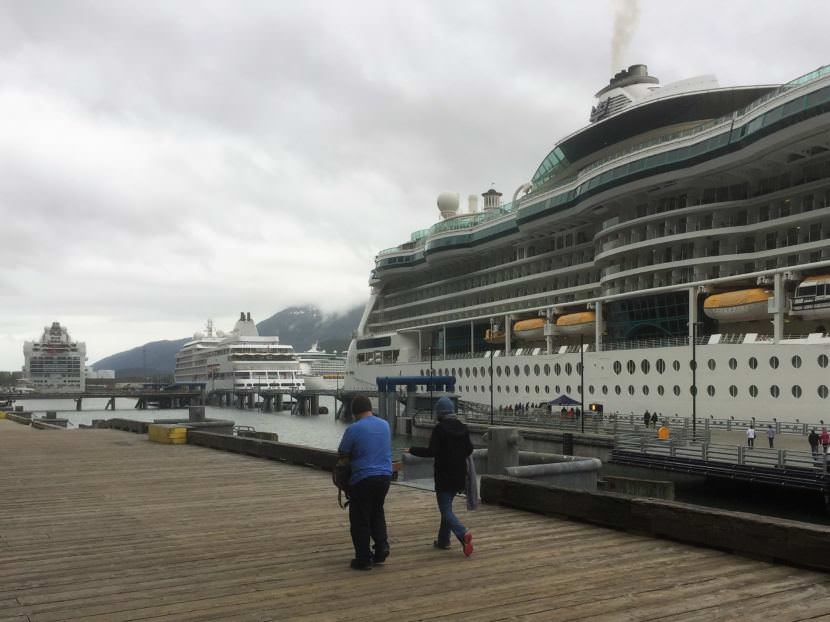
The number of cruise ship passengers visiting Alaska will jump almost 20 percent over the next two years.
Port cities need to plan for the infrastructure needed to support that many people.
One industry idea could change community control of the fees cruise ships pay.
Cruise lines are bringing more and more tourists to Alaska.
Passenger numbers topped a million for the first time last summer.
Cruise Lines International Association Alaska President John Binkley said they’ll continue to go up.
About 1.31 million passengers are expected to arrive in 2019, 19 percent more than last summer, according to projections Binkley released at the recent Southeast Conference Mid Session Summit.
“Sometimes there’s new ships that are coming into the market,” Binkley said. “Sometimes there’s larger ships that are replacing smaller ships. And sometimes they’re adding to the shoulder seasons to have more voyages.”
Starting this summer, the larger ships will really be larger.
The Norwegian Bliss will carry up to 4,000 passengers, plus crew, starting this June.
The Ovation of the Seas will come in the following year, with as many as 5,000 passengers per sailing, double the capacity of some ships already traveling the region.
Binkley said the growth requires more infrastructure.
“It’s not just one community having the facilities to be able to handle that ship,” he said. “You have to have at least three ports to be able to have a ship like that be able to deploy to Alaska,” Binkley said.
Only Ketchikan, Juneau and Skagway can handle such vessels.
They’re the biggest Southeast ports and they get the largest share of passenger fees.
Binkley said those total about $45 million a year, statewide. He said pooling that would allow other cities to boost their industries, too.
“We could be building a brand new dock each and every year in new communities around Southeast Alaska if we worked together and said … what’s the best way to take these dollars that we have and utilize them to grow the industry and have everybody in Southeast share and benefit from the industry,” Binkley said.
It’s not a formal proposal, but the cruise association has already sued the capital city, challenging local control of how such funds are used.
Juneau City Manager Rorie Watt agrees more regional planning is needed. But he takes a different approach. He invited other community leaders to join the Southeast Cruise Port Association, which held its first meeting during the Mid Session Summit.
“I’m not under any illusion that we’re all going to cede local control of our communities to each other,” Watt said. “But I think we can get together on some very broad ideas.”
Those include improved communication and regional readiness for changes, such as quickly growing passenger numbers.
The industry’s share-the-wealth idea is of interest to Russell Dick, CEO of the Huna Totem Corp., which owns the Icy Strait Point attraction.
The renovated cannery and mile-long zip line completed its first dock two years ago, which brought more ships and visitors.
Dick said it’s looking toward construction of a second dock, which would support further growth.
“It’s all about tour capacity, having the infrastructure in place to handle the increase in ships and ship passengers,” Dick said. “And for us, that’s quite a bit. That’s a lot of people coming through.”
The cruise business is a significant part of Alaska’s visitor industry.
A cruise association report said ships, passengers and crew members spent about $1 billion during last summer’s season. And the passengers made up more than half of all visitors to the state.
Ed Schoenfeld is Regional News Director for CoastAlaska, a consortium of public radio stations in Ketchikan, Juneau, Sitka, Petersburg and Wrangell.
He primarily covers Southeast Alaska regional topics, including the state ferry system, transboundary mining, the Tongass National Forest and Native corporations and issues.
He has also worked as a manager, editor and reporter for the Juneau Empire newspaper and Juneau public radio station KTOO. He’s also reported for commercial station KINY in Juneau and public stations KPFA in Berkley, WYSO in Yellow Springs, Ohio, and WUHY in Philadelphia. He’s lived in Alaska since 1979 and is a contributor to Alaska Public Radio Network newscasts, the Northwest (Public Radio) News Network and National Native News. He is a board member of the Alaska Press Club. Originally from Cleveland, Ohio, he lives in Douglas.




